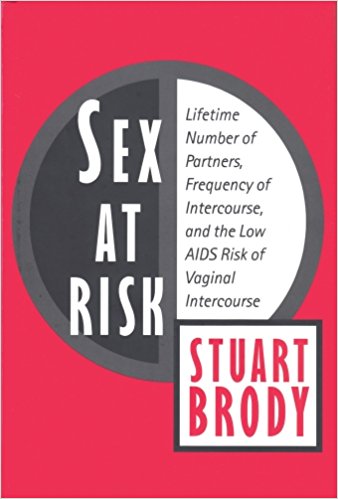Sex, Lies, Race, and AIDS
Thomas Jackson, American Renaissance, November 1997
Sex At Risk: Lifetime Number of Partners, Frequency of Intercourse, and the Low AIDS Risk of Vaginal Intercourse, Stuart Brody, Transaction Publishers, 222 pp.
Although the subtitle of this curious little volume suggests a coherent theme, Sex At Risk is basically three unrelated essays in a single cover. None is specifically about race, but the essay on AIDS transmission includes racial data that are particularly interesting in light of the review of Michael Levin’s Why Race Matters in the previous issue of AR.

In this essay, Mr. Brody argues that the risk of a generally healthy person contracting AIDS through vaginal intercourse is virtually nil. He writes that one reason many people think vaginal intercourse is risky is because homosexuals and drug injectors sometimes lie, claiming to have gotten the disease through sex with women. Every undetected lie becomes another recorded but bogus case of vaginally transmitted AIDS.
Mr. Brody points out that many AIDS surveys of heterosexuals do not distinguish between vaginal and anal intercourse. This distinction is crucial. The protective lining of the rectum is much thinner than that of the vagina and is easily ruptured during intercourse, thus permitting passage of the AIDS virus. By failing to distinguish between anal and vaginal intercourse, surveys often leave the mistaken impression that a woman who actually got AIDS through anal intercourse contracted it vaginally. Even when studies distinguish between these two activities, heterosexuals sometimes lie about what they do.
Mr. Brody writes that homosexual activists have encouraged belief in vaginal transmission so as to make AIDS appear to be a general threat rather than “a disease of undesirables.” However, they could not promote this view without the help of people who are willing to lie, and Mr. Brody’s comparative data in this area are striking.
On the general subject of the willingness of people to lie about drug use, Mr. Brody notes a longitudinal study of young adults who were asked in 1980 and again in 1984 if they had ever used marijuana. Of the people who said “yes” in 1980, eight percent of the men and 12 percent of the women said “no” four years later. Women were therefore 50 percent more likely than men to give inconsistent replies, but blacks and Hispanics were 200 percent, or twice as likely as whites, to change their stories.
Mr. Brody also reports studies of what people say to others after they have been officially informed that they are HIV positive: 20 to 40 percent either claim they are negative or that they have never been tested, with blacks and Hispanics considerably more likely than to lie than whites. In a study of alcoholics and drug users, 25 percent of whites and 65 percent of blacks lied about the results. Among bisexual men, blacks are less likely than whites to tell their female partners about their potentially lethal homosexual activities.
Mr. Brody notes that non-whites consistently give more “socially desirable” answers to survey questions than whites do, and that women lie more often than men. He suspects that differences in the willingness to lie explain much of the variation in the reported percentages of the various groups who claim to have gotten the virus through heterosexual intercourse: white men — 0.7 percent, black men — 3.1 percent, white women — 12.1 percent, black women — 15 percent. Of course, to the extent that women are infected by bisexual men who claim to be heterosexual, their high rates of claimed heterosexual infection may reflect their partners’ dishonesty rather than their own.
Entirely apart from the issue of truthfulness, the behavior and perhaps even the biology of non-whites may contribute to their relatively high rates of AIDS. For example, if they are in jail, men who are ordinarily heterosexual may have anal intercourse (voluntarily or involuntarily). Since blacks are six to ten times more likely than whites to be in jail, and since unprotected anal intercourse is one of the most common ways to get AIDS, this contributes to high rates among blacks. It has also been found that black bisexuals have, on average, twice as many female partners as white bisexuals, and are 50 percent more likely to engage in anal intercourse with them.
Arguing by analogy from other sexually transmitted diseases, Mr. Brody suggests the possibility that blacks are biologically more susceptible than whites to AIDS. Syphilis rates among blacks are as much as 50 times higher than among whites. Standard transmission models for venereal disease cannot explain such high rates, even considering that blacks have more sex partners. One interesting study of sailors on shore leave who frequented infected prostitutes found that blacks had a one-in-two chance per exposure of getting gonorrhea whereas whites had a one-in-five chance. There may be unknown biological characteristics that explain this difference.
Behavior and biology may both help explain high rates of “heterosexual” AIDS in Africa. Anal intercourse is a common form of contraception among Africans. Female genital mutilation may also encourage anal intercourse if the vagina is painful or never heals completely. An improperly healed vagina is also a less effective barrier against infection during vaginal intercourse. At the same time, African medical personnel often reuse hypodermic needles without sterilizing them, and widespread chronic disease makes Africans generally more susceptible to HIV.
In sex and disease, as in so many other things, the facts bear out Prof. Levin’s contention that race does, indeed, matter.















